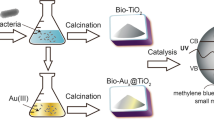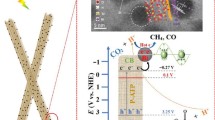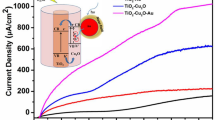Abstract
Biomass photoreforming is a prospective and attractive strategy to kill two birds with one stone for not only producing hydrogen (H2) but also valorizing biomass by exploiting infinite solar energy. Here, we design Ni-Au bimetal nanoparticles modified urchin-like TiO2 photocatalysts (NiAu/TiO2) and demonstrate an enhanced glucose photoreforming. The H2 production rate of the optimal Ni0.05Au0.45/TiO2 (6391.86 μmol h−1 g−1) is 118.57, 30.78, and 1.65 times of pure TiO2 (53.91 μmol h−1 g−1), Ni0.5/TiO2 (207.56 μmol h−1 g−1), and Au0.5/TiO2 (3867.12 μmol h−1 g−1), respectively. Meanwhile, the glucose conversion rate and the corresponding arabinose selectivity over Ni0.05Au0.45/TiO2 are up to 95.00% and 36.54% after 4-h photoreforming, which are higher than the corresponding monometallic and pristine TiO2. The synergistic effect of Ni and Au nanoparticles, including the localized surface plasmon resonance (LSPR) and Schottky junction of Au nanoparticles and the promoting effect of Ni particles on C–C cleavage in glucose, as well as the three-dimensional hierarchical urchin-like TiO2, significantly improve the H2 production, glucose conversion, and arabinose selectivity. The research paves a new way to the great potential of bimetal nanoparticles in biomass photoreforming.









Similar content being viewed by others
References
Zhao H, Li CF, Yong X, Kumar P, Palma B, Hu ZY, Van Tendeloo G, Siahrostami S, Larter S, Zheng D, Wang S, Chen Z, Kibria MG, Hu J (2021) Coproduction of hydrogen and lactic acid from glucose photocatalysis on band-engineered Zn1-xCdxS homojunction. iScience 24:102109–102120. https://doi.org/10.1016/j.isci.2021.102109
Pan D, Su F, Liu H, Liu C, Umar A, Castañeda L, Algadi H, Wang C, Guo Z (2021) Research progress on catalytic pyrolysis and reuse of waste plastics and petroleum sludge. ES Mater Manuf 11:3–15. https://doi.org/10.30919/esmm5f415
Ragauskas AJ, Williams CK, Davison BH, Britovsek G, Cairney J, Eckert CA, Frederick WJ Jr, Hallett JP, Leak DJ, Liotta CL, Mielenz JR, Murphy R, Templer R, Tschaplinski T (2006) The path forward for biofuels and biomaterials. Science 311:484–489. https://doi.org/10.1126/science.1114736
Zhao H, Liu P, Wu X, Wang A, Zheng D, Wang S, Chen Z, Larter S, Li Y, Su B-L, Kibria MG, Hu J (2021) Plasmon enhanced glucose photoreforming for arabinose and gas fuel co-production over 3DOM TiO2-Au. Appl Catal B Environ 291:120055–120064. https://doi.org/10.1016/j.apcatb.2021.120055
Kuehnel MF, Reisner E (2018) Solar hydrogen generation from lignocellulose. Angew Chem Int Ed Engl 57:3290–3296. https://doi.org/10.1002/anie.201710133
Caravaca A, Jones W, Hardacre C, Bowker M (2016) H2 production by the photocatalytic reforming of cellulose and raw biomass using Ni, Pd, Pt and Au on titania. Proc Math Phys Eng Sci 472:20160054–20160065. https://doi.org/10.1098/rspa.2016.0054
Liu WJ, Xu Z, Zhao D, Pan XQ, Li HC, Hu X, Fan ZY, Wang WK, Zhao GH, Jin S, Huber GW, Yu HQ (2020) Efficient electrochemical production of glucaric acid and H2 via glucose electrolysis. Nat Commun 11:265–276. https://doi.org/10.1038/s41467-019-14157-3
Zhang Z, Huber GW (2018) Catalytic oxidation of carbohydrates into organic acids and furan chemicals. Chem Soc Rev 47:1351–1390. https://doi.org/10.1039/c7cs00213k
Zhang P, Sun D, Cho A, Weon S, Lee S, Lee J, Han JW, Kim DP, Choi W (2019) Modified carbon nitride nanozyme as bifunctional glucose oxidase-peroxidase for metal-free bioinspired cascade photocatalysis. Nat Commun 10:940–954. https://doi.org/10.1038/s41467-019-08731-y
Zhou B, Song J, Wu T, Liu H, Xie C, Yang G, Han B (2016) Simultaneous and selective transformation of glucose to arabinose and nitrosobenzene to azoxybenzene driven by visible-light. Green Chem 18:3852–3857. https://doi.org/10.1039/c6gc00943c
Sanwald KE, Berto TF, Eisenreich W, Jentys A, Gutiérrez OY, Lercher JA (2017) Overcoming the rate-limiting reaction during photoreforming of sugar aldoses for H2-generation. ACS Catal 7:3236–3244. https://doi.org/10.1021/acscatal.7b00508
Chong R, Li J, Ma Y, Zhang B, Han H, Li C (2014) Selective conversion of aqueous glucose to value-added sugar aldose on TiO2-based photocatalysts. J Catal 314:101–108. https://doi.org/10.1016/j.jcat.2014.03.009
Zhao Y, Zeng Q, Feng T, Xia C, Liu C, Yang F, Zhang K, Yang B (2019) Carbonized polymer dots/TiO2 photonic crystal heterostructures with enhanced light harvesting and charge separation for efficient and stable photocatalysis. Mater Chem Front 3:2659–2667. https://doi.org/10.1039/c9qm00556k
Silva CG, Sampaio MJ, Marques RRN, Ferreira LA, Tavares PB, Silva AMT, Faria JL (2015) Photocatalytic production of hydrogen from methanol and saccharides using carbon nanotube-TiO2 catalysts. Appl Catal B Environ 178:82–90. https://doi.org/10.1016/j.apcatb.2014.10.032
Yu X, Fan X, An L, Liu G, Li Z, Liu J, Hu P (2018) Mesocrystalline Ti3+ TiO2 hybridized g-C3N4 for efficient visible-light photocatalysis. Carbon 128:21–30. https://doi.org/10.1016/j.carbon.2017.11.078
Roongraung K, Chuangchote S, Laosiripojana N, Sagawa T (2020) Electrospun Ag-TiO2 nanofibers for photocatalytic glucose conversion to high-value chemicals. ACS Omega 5:5862–5872. https://doi.org/10.1021/acsomega.9b04076
Luna AL, Dragoe D, Wang K, Beaunier P, Kowalska E, Ohtani B, Bahena Uribe D, Valenzuela MA, Remita H, Colbeau-Justin C (2017) Photocatalytic hydrogen evolution using Ni–Pd/TiO2: correlation of light absorption, charge-carrier dynamics, and quantum efficiency. J Phy Chem C 121:14302–14311. https://doi.org/10.1021/acs.jpcc.7b01167
Shi C, Yuan W, Qu K, Shi J, Eqi M, Tan X, Huang Z, Gándara F, Pan D, Naik N, Zhang Y, Guo Z (2021) Gold/titania nanorod assembled urchin-like photocatalysts with an enhanced hydrogen generation by photocatalytic biomass reforming. Eng Sci 16:374–386. https://doi.org/10.30919/es8d478
Zhao H, Li CF, Liu LY, Palma B, Hu ZY, Renneckar S, Larter S, Li Y, Kibria MG, Hu J, Su BL (2021) n-p Heterojunction of TiO2-NiO core-shell structure for efficient hydrogen generation and lignin photoreforming. J Colloid Interface Sci 585:694–704. https://doi.org/10.1016/j.jcis.2020.10.049
Davda RR, Shabaker JW, Huber GW, Cortright RD, Dumesic JA (2005) A review of catalytic issues and process conditions for renewable hydrogen and alkanes by aqueous-phase reforming of oxygenated hydrocarbons over supported metal catalysts. Appl Catal B Environ 56:171–186. https://doi.org/10.1016/j.apcatb.2004.04.027
Zhang J, Zhu Y, An Z, Shu X, Ma X, Song H, Wang W, He J (2020) Size effects of Ni particles on the cleavage of C-H and C–C bonds toward hydrogen production from cellulose. ACS Appl Energy Mater 3:7048–7057. https://doi.org/10.1021/acsaem.0c01104
Kalisman P, Houben L, Aronovitch E, Kauffmann Y, Bar-Sadan M, Amirav L (2015) The golden gate to photocatalytic hydrogen production. J Mater Chem A 3:19679–19682. https://doi.org/10.1039/c5ta05784a
Zheng X, Shen G, Wang C, Li Y, Dunphy D, Hasan T, Brinker CJ, Su BL (2017) Bio-inspired murray materials for mass transfer and activity. Nat Commun 8:14921–14930. https://doi.org/10.1038/ncomms14921
Tudu B, Nalajala N, Saikia P, Gopinath CS (2020) Cu–Ni Bimetal Integrated TiO2 Thin film for enhanced solar hydrogen generation. Sol RRL 4:1900557–1900567. https://doi.org/10.1002/solr.201900557
Wang Y, Zhang S, Huang C, Qu F, Yao D, Guo H, Xu H, Jiang C, Yang M (2021) Mesoporous WO3 modified by Au nanoparticles for enhanced trimethylamine gas sensing properties. Dalton Trans 50:970–978
Wang Y, Zhang S, Huang C, Qu F, Yao D, Guo H, Xu H, Jiang C, Yang M (2021) Mesoporous WO3 modified by Au nanoparticles for enhanced trimethylamine gas sensing properties. Dalton T 50:970–978. https://doi.org/10.1039/d0dt03131c
Yu X, Fan X, Li Z, Liu J (2017) Synthesis of plasmonic Ti3+ doped Au/Cl-TiO2 mesocrystals with enhanced visible light photocatalytic activity. Dalton T 46:11898–11904. https://doi.org/10.1039/c7dt02824e
Yu Y, Dong X, Chen P, Geng Q, Wang H, Li J, Zhou Y, Dong F (2021) Synergistic effect of Cu single atoms and Au-Cu alloy nanoparticles on TiO2 for efficient CO2 photoreduction. ACS Nano 15:14453–14464. https://doi.org/10.1021/acsnano.1c03961
Qin L, Si G, Li X, Kang S-Z (2015) Synergetic effect of Cu–Pt bimetallic cocatalyst on SrTiO3 for efficient photocatalytic hydrogen production from water. RSC Adv 5:102593–102598. https://doi.org/10.1039/c5ra22757g
Patra KK, Gopinath CS (2016) Bimetallic and plasmonic Ag-Au on TiO2 for solar water splitting: an active nanocomposite for entire visible-light-region absorption. ChemCatChem 8:3294–3311. https://doi.org/10.1002/cctc.201600937
Bharad PA, Sivaranjani K, Gopinath CS (2015) A rational approach towards enhancing solar water splitting: a case study of Au-RGO/N-RGO-TiO2. Nanoscale 7:11206–11215. https://doi.org/10.1039/c5nr02613j
Sivaranjani K, RajaAmbal S, Das T, Roy K, Bhattacharyya S, Gopinath CS (2014) Disordered mesoporous TiO2−xNx nano-Au: an electronically integrated nanocomposite for solar H2 generation. ChemCatChem 6:522–530. https://doi.org/10.1002/cctc.201300715
Tudu B, Nalajala N, Reddy KP, Saikia P, Gopinath CS (2019) Electronic integration and thin film aspects of Au-Pd/rGO/TiO2 for improved solar hydrogen generation. ACS Appl Mater Interfaces 11:32869–32878. https://doi.org/10.1021/acsami.9b07070
Yan Y, Xia BY, Zhao B, Wang X (2016) A review on noble-metal-free bifunctional heterogeneous catalysts for overall electrochemical water splitting. J Mater Chem A 4:17587–17603. https://doi.org/10.1039/c6ta08075h
Xu J, Li M, Yang L, Qiu J, Chen Q, Zhang X, Feng Y, Yao J (2020) Synergy of Ni dopant and oxygen vacancies in ZnO for efficient photocatalytic depolymerization of sodium lignosulfonate. Chem Eng J 394:125050–125070. https://doi.org/10.1016/j.cej.2020.125050
Jiang B, Tang Y, Qu Y, Wang JQ, Xie Y, Tian C, Zhou W, Fu H (2015) Thin carbon layer coated Ti3+-TiO2 nanocrystallites for visible-light driven photocatalysis. Nanoscale 7:5035–5045. https://doi.org/10.1039/c5nr00032g
Fang W, Xing M, Zhang J (2014) A new approach to prepare Ti3+ self-doped TiO2 via NaBH4 reduction and hydrochloric acid treatment. Appl Catal B Environ 160:240–246. https://doi.org/10.1016/j.apcatb.2014.05.031
Xing M, Fang W, Nasir M, Ma Y, Zhang J, Anpo M (2013) Self-doped Ti3+ -enhanced TiO2 nanoparticles with a high-performance photocatalysis. J Catal 297:236–243. https://doi.org/10.1016/j.jcat.2012.10.014
Guo F, Sun H, Cheng L, Shi W (2020) Oxygen-defective ZnO porous nanosheets modified by carbon dots to improve their visible-light photocatalytic activity and gain mechanistic insight. New J Chem 44:11215–11223. https://doi.org/10.1039/d0nj02268c
Geng Z, Kong X, Chen W, Su H, Liu Y, Cai F, Wang G, Zeng J (2018) Oxygen vacancies in ZnO nanosheets enhance CO2 electrochemical reduction to CO. Angew Chem Int Ed Engl 57:6054–6059. https://doi.org/10.1002/anie.201711255
Nowotny J, Alim MA, Bak T, Idris MA, Ionescu M, Prince K, Sahdan MZ, Sopian K, Mat Teridi MA, Sigmund W (2015) Defect chemistry and defect engineering of TiO2-based semiconductors for solar energy conversion. Chem Soc Rev 44:8424–8442. https://doi.org/10.1039/c4cs00469h
Zhang B, Wang L, Zhang Y, Ding Y, Bi Y (2018) Ultrathin FeOOH nanolayers with abundant oxygen vacancies on BiVO4 photoanodes for efficient water oxidation. Angew Chem Int Ed Engl 57:2248–2252. https://doi.org/10.1002/anie.201712499
Zhang Y, Xu Z, Li G, Huang X, Hao W, Bi Y (2019) Direct observation of oxygen vacancy self-healing on TiO2 photocatalysts for solar water splitting. Angew Chem Int Ed Engl 58:14229–14233. https://doi.org/10.1002/anie.201907954
Li C, Wang T, Zhao ZJ, Yang W, Li JF, Li A, Yang Z, Ozin GA, Gong J (2018) Promoted fixation of molecular nitrogen with surface oxygen vacancies on plasmon-enhanced TiO2 photoelectrodes. Angew Chem Int Ed Engl 57:5278–5282. https://doi.org/10.1002/anie.201713229
Yu H, Li J, Zhang Y, Yang S, Han K, Dong F, Ma T, Huang H (2019) Three-in-one oxygen vacancies: whole visible-spectrum absorption, efficient charge separation, and surface site activation for robust CO2 photoreduction. Angew Chem Int Ed Engl 58:3880–3884. https://doi.org/10.1002/anie.201813967
Chowdhury IH, Roy M, Kundu S, Naskar MK (2019) TiO2 hollow microspheres impregnated with biogenic gold nanoparticles for the efficient visible light-induced photodegradation of phenol. J Phys Chem Solids 129:329–339. https://doi.org/10.1016/j.jpcs.2019.01.036
Kang F, Shi C, Li W, Eqi M, Liu Z, Zheng X, Huang Z (2022) Honeycomb like CdS/sulphur-modified biochar composites with enhanced adsorption-photocatalytic capacity for effective removal of rhodamine B. J Environ Chem Eng 10:106942–106953. https://doi.org/10.1016/j.jece.2021.106942
Lin Z, Du C, Yan B, Wang C, Yang G (2018) Two-dimensional amorphous NiO as a plasmonic photocatalyst for solar H2 evolution. Nat Commun 9:4036
Vinesh V, Shaheer ARM, Neppolian B (2019) Reduced graphene oxide (rGO) supported electron deficient B-doped TiO2 (Au/B-TiO2/rGO) nanocomposite: an efficient visible light sonophotocatalyst for the degradation of tetracycline (TC). Ultrason Sonochem 50:302–310. https://doi.org/10.1016/j.ultsonch.2018.09.030
Makula P, Pacia M, Macyk W (2018) How to correctly determine the band gap energy of modified semiconductor photocatalysts based on UV-Vis spectra. J Phys Chem Lett 9:6814–6817. https://doi.org/10.1021/acs.jpclett.8b02892
Valan MF, Manikandan A, Antony SA (2015) A novel synthesis and characterization studies of magnetic Co3O4 nanoparticles. J Nanosci Nanotechnol 15:4580–4586. https://doi.org/10.1166/jnn.2015.9776
Quesada-Cabrera R, Sotelo-Vazquez C, Bear JC, Darr JA, Parkin IP (2014) Photocatalytic evidence of the rutile-to-anatase electron transfer in titania. Adv Mater Interfaces 1:1400069–1400076. https://doi.org/10.1002/admi.201400069
Nosaka Y, Nosaka AY (2016) Reconsideration of intrinsic band alignments within anatase and rutile TiO2. J Phys Chem Lett 7:431–434. https://doi.org/10.1021/acs.jpclett.5b02804
Scanlon DO, Dunnill CW, Buckeridge J, Shevlin SA, Logsdail AJ, Woodley SM, Catlow CR, Powell MJ, Palgrave RG, Parkin IP, Watson GW, Keal TW, Sherwood P, Walsh A, Sokol AA (2013) Band alignment of rutile and anatase TiO2. Nat Mater 12:798–801. https://doi.org/10.1038/nmat3697
Zhao H, Yu X, Li C-F, Yu W, Wang A, Hu Z-Y, Larter S, Li Y, Golam Kibria M, Hu J (2022) Carbon quantum dots modified TiO2 composites for hydrogen production and selective glucose photoreforming. J Energy Chem 64:201–208. https://doi.org/10.1016/j.jechem.2021.04.033
Di J, Xia J, Yin S, Xu H, Xu L, Xu Y, He M, Li H (2014) Preparation of sphere-like g-C3N4/BiOI photocatalysts via a reactable ionic liquid for visible-light-driven photocatalytic degradation of pollutants. J Mater Chem A 2:5340–5351. https://doi.org/10.1039/c3ta14617k
Yang M-Q, Han C, Xu Y-J (2015) Insight into the effect of highly dispersed MoS2 versus layer-structured MoS2 on the photocorrosion and photoactivity of CdS in graphene–CdS–MoS2 composites. J Phys Chem C 119:27234–27246. https://doi.org/10.1021/acs.jpcc.5b08016
Shi C, Qi H, Sun Z, Qu K, Huang Z, Li J, Dong M, Guo Z (2020) Carbon dot-sensitized urchin-like Ti3+ self-doped TiO2 photocatalysts with enhanced photoredox ability for highly efficient removal of Cr6+ and RhB. J Mate Chem C 8:2238–2247. https://doi.org/10.1039/c9tc05513d
Bai Y, Ye L, Chen T, Wang L, Shi X, Zhang X, Chen D (2016) Facet-dependent photocatalytic N2 fixation of bismuth-rich Bi5O7I nanosheets. ACS Appl Mater Interfaces 8:27661–27668. https://doi.org/10.1021/acsami.6b08129
Abdouli I, Eternot M, Dappozze F, Guillard C, Essayem N (2021) Comparison of hydrothermal and photocatalytic conversion of glucose with commercial TiO2: superficial properties-activities relationships. Catal Today 367:268–277. https://doi.org/10.1016/j.cattod.2020.03.040
Da Vià L, Recchi C, Gonzalez-Yañez EO, Davies TE, Lopez-Sanchez JA (2017) Visible light selective photocatalytic conversion of glucose by TiO2. Appl Catal B Environ 202:281–288. https://doi.org/10.1016/j.apcatb.2016.08.035
Chen W-T, Chan A, Sun-Waterhouse D, Llorca J, Idriss H, Waterhouse GIN (2018) Performance comparison of Ni/TiO2 and Au/TiO2 photocatalysts for H2 production in different alcohol-water mixtures. J Catal 367:27–42. https://doi.org/10.1016/j.jcat.2018.08.015
Bellardita M, García-López EI, Marcì G, Palmisano L (2016) Photocatalytic formation of H2 and value-added chemicals in aqueous glucose (Pt)-TiO2 suspension. Int J Hydrogen Energ 41:5934–5947. https://doi.org/10.1016/j.ijhydene.2016.02.103
Bahadori E, Ramis G, Zanardo D, Menegazzo F, Signoretto M, Gazzoli D, Pietrogiacomi D, Michele AD, Rossetti I (2020) Photoreforming of glucose over CuO/TiO2. Catalysts 10:477–497. https://doi.org/10.3390/catal10050477
Funding
This work was supported by the National Natural Science Foundation of China (No. 32071713), the Outstanding Youth Foundation Project of Heilongjiang Province (No. JQ2019C001), the Natural Science Basic Research Program of Shaanxi (Grant No. 2022JQ-441), and the Central University Basic Scientifc Research Project of China (No. 2572020DX01).
Ethics declarations
Conflict of interest
The authors declare no competing interests.
Additional information
Publisher's Note
Springer Nature remains neutral with regard to jurisdictional claims in published maps and institutional affiliations.
Malin Eqi and Cai Shi contributed equally to this work.
Supplementary Information
Below is the link to the electronic supplementary material.
Rights and permissions
Springer Nature or its licensor (e.g. a society or other partner) holds exclusive rights to this article under a publishing agreement with the author(s) or other rightsholder(s); author self-archiving of the accepted manuscript version of this article is solely governed by the terms of such publishing agreement and applicable law.
About this article
Cite this article
Eqi, M., Shi, C., Xie, J. et al. Synergetic effect of Ni-Au bimetal nanoparticles on urchin-like TiO2 for hydrogen and arabinose co-production by glucose photoreforming. Adv Compos Hybrid Mater 6, 5 (2023). https://doi.org/10.1007/s42114-022-00580-6
Received:
Revised:
Accepted:
Published:
DOI: https://doi.org/10.1007/s42114-022-00580-6




